Zoom
Trash
Related: TUTORIELS, COURS, CONSEILS etc...
- Dev
- Softs
- Angular
- Web et outils de developpement
- Angular4-7
- to_test
- Angular
- JavaScript
- Education
- Enterprise

Angular/angular-cli: CLI tool for Angular2. Sing App - Web & Angular 2.0 Dashboard. Mobile Angular UI - Angular JS Mobile UI framework with Bootstrap 3 Css. Ng2-treeview/treeview.component.ts at master · martinsik/ng2-treeview. Recursive TreeView in Angular 2.0. In this post I will demonstrate how to create a simple treeview using Angular 2.0 and TypeScript.
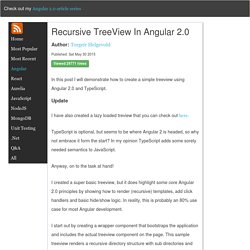
Update I have also created a lazy loaded treview that you can check out here. TypeScript is optional, but seems to be where Angular 2 is headed, so why not embrace it form the start? In my opinion TypeScript adds some sorely needed semantics to JavaScript. Anyway, on to the task at hand! I created a super basic treeview, but it does highlight some core Angular 2.0 principles by showing how to render (recursive) templates, add click handlers and basic hide/show logic. I start out by creating a wrapper component that bootstraps the application and includes the actual treeview component on the page.
App.ts I won't go into a lot of details about the specific component syntax since the Angular team has already released pretty good references and samples. Angular 2 Demos. Blog Technique Xebia - Cabinet de conseil IT. Courant mai 2015, la team d’Angular a étiqueté la version 2.0.0-alpha.27 (version du 09/12/2015 : alpha.50) en version dite de « Developer Preview ».
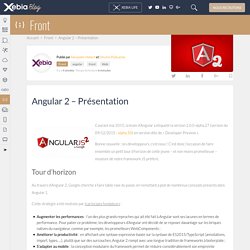
Bonne nouvelle : les développeurs, c’est nous ! C’est donc l’occasion de faire ensemble un petit tour d’horizon de cette jeune – et non moins prometteuse – mouture de notre framework JS préféré. Tour d’horizon Au travers d’Angular 2, Google cherche à faire table rase du passé, en remettant à plat de nombreux concepts présents dans Angular 1. Cette stratégie a été motivée par 4 principes fondateurs : Augmenter les performances : l’un des plus grands reproches qui ait été fait à Angular sont ses lacunes en termes de performance. Plus d’informations ici : Rupture avec l’existant Des « directives » aux « scopes », en passant par le « two-way data binding », Angular 2 n’en garde que les stigmates. Voici une liste non exhaustive des concepts qui disparaissent : Sous le capot TypeScript Dois-je utiliser TypeScript ?
Performances Migration… Angular 2 and the future of HTML5 apps. Welcome back.
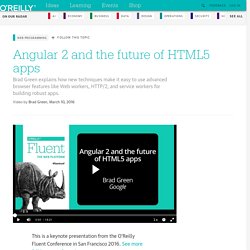
Please sign in. Welcome back. {* #userInformationForm *} {* traditionalSignIn_emailAddress *} {* traditionalSignIn_password *} {* traditionalSignIn_signInButton *} {* /userInformationForm *} Please confirm the information below before signing in. {* #socialRegistrationForm *} {* socialRegistration_firstName *} {* socialRegistration_lastName *} {* socialRegistration_displayName *} {* socialRegistration_emailAddress *} {* providerName *} {* profileURL *} {* profilePreferredUsername *} {* profileIdentifier *} {* /socialRegistrationForm *}
All About Angular 2.0. Have questions about the strategy for Angular 2.0?
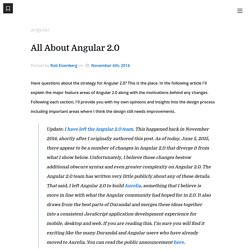
This is the place. In the following article I'll explain the major feature areas of Angular 2.0 along with the motivations behind any changes. Following each section, I'll provide you with my own opinions and insights into the design process including important areas where I think the design still needs improvements. Update: I have left the Angular 2.0 team. This happened back in November 2014, shortly after I originally authored this post. Before we get started talking about the future of Angular, let's take a moment to look at the current version. You probably have a bunch of questions about the future of AngularJS right now. Angular 2 - Hello World (es5) - angular2 Video Tutorial #free.
To use plain, old ES5 JavaScript so you don't have to worry about TypeScript or anything, just grab the SFX bundle.
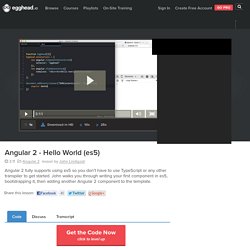
Then I'll just write all the code in this app.js file. In my index HTML, I'm just going to add an egghead tag, and that's where I'll leave it at, and I'll never touch this again. In my app.js file I'm going to create a constructor function called "Egghead. " Then instead of writing anything inside of the constructor function, I'm going to add an annotations property here, which is just an array. Now inside of this array we're going to pass in two things, a component annotation and a view annotation. If you remember, we called our element "Egghead," so we'll just use the "Selector of egghead. " Now that we have our egghead component set up, all we've to do is bootstrap it, but we do need to wait for the dom to be ready, so we'll start with document add "Event listener.
" So, you never have to bootstrap another component. Angular 2 : Savoir composer avec les composants. Peu importe notre préférence en matière de framework front end JavaScript, AngularJS a modernisé notre façon de concevoir et réaliser des applications web riches, stables et performantes.

Convaincus par AngularJS, nous suivons de près le projet Angular 2, qui s’annonce radicalement différent de son prédécesseur. En effet, le framework a été entièrement réécrit. Il se veut plus simple et plus performant en tirant profit des nouvelles technologies du web telles que ES2015 et les Web Components. A l’heure où nous écrivons cet article, le projet est en phase bêta. Les releases sont publiques sur GitHub et la documentation technique est régulièrement mise à jour par l’équipe AngularJS. Un article sur les composants De nombreux changements ont été apportés dans cette nouvelle version d’AngularJS mais l’innovation majeure selon nous est le nouveau modèle orienté composants. Qu’est-ce donc un composant ?